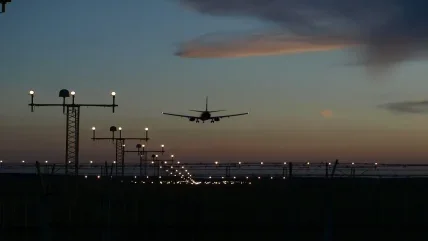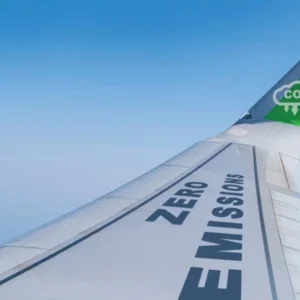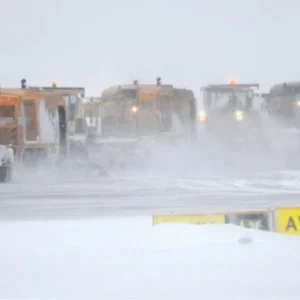
For six months a year, the US Midwest is an infamously snowbound place. From Michigan to the Dakotas, thousands of communities revel in the chill. In the small Wisconsin town of Lake Geneva, to give but one example, residents host the National Snow Sculpting Championship, a 72-hour competition where beer-swilling Berninis sculpt pixies and dragons from blocks of ice. Local governments get active too. Minnesota’s government owns 800 snowploughs, undoubtedly wise for a state where it snows an average of 43in a year. It’s little wonder Wisconsinites jokingly dismiss their western neighbours as ‘Minne-snow-tans’.
Yet it’s arguably nearby Iowa that faces the fiercest winters of all. This is the place, after all, where the word ‘blizzard’ was first coined, by shivering German settlers adapting their word for ‘lightning’ in the mid-19th century. And though their gnarled wooden cabins have long since vanished, modern Iowans still struggle with the snow – not least in their airports. Representative is a storm in January 2021, where 12.9in fell on Des Moines International Airport over a two-day period. Flight cancellations inevitably followed, something that happens almost every year. Of course, the upper Midwest is far from alone. Every year, winter weather forces the cancellation of around 60,000 flights across all 50 US states, costing the industry $3bn.
Unsurprisingly, local officials don’t sit impassively as the storms roll in. As Dr Matthew Brynick explains, every airport has a “unique approach” to deal with snow and ice, and Des Moines is no different. “Vehicle-mounted snow blowers, brushes, and ploughs are common,” says Brynick, a civil engineer at the FAA William J Hughes Technical Center in New Jersey. “Chemicals, sand, snow melting and treatment facilities, and snow storage are utilised when appropriate.” All this is clearly supported by the statistics. Des Moines International has around ten snow ploughs, each costing $900,000, while airports regularly spend $20,000 on the chemicals needed for a standard de-icing session.
Yet though these methods are tried and tested, they’re also far from perfect. Snow ploughs might weigh 50,000lb when loaded, but even expensive models are often painfully inept. In the worst squalls, they have to be deployed to the runway every 15 minutes, leaving precious little time for the aircraft themselves. De-icing chemicals are similarly inefficient. Halil Ceylan, a professor at Iowa State University, describes visiting Minneapolis-Saint Paul International Airport and seeing “85 workers sitting around the clock” in specialised barracks, complete with sleeping quarters and a canteen. Their only job? To decontaminate polluted snow.
On that point, de-icing can cause huge environmental problems when left untreated, killing fish and sparking toxic algae blooms. According to an estimate by the Environmental Protection Agency (EPA), the US’s large hub airports discharge over one million tonnes of ammonia each year. To put that into perspective, drinking water in the US normally contains just 0.25mg of the compound per litre. Nor are these hypothetical problems. At New York’s JFK, for instance, de-icing runoff flowed into a nearby nature reserve as recently as 2009.
Seeing green
Ames is not necessarily the place you’d expect to find a solution to these deep global troubles. A genteel college town of 66,000, it wallows amiably in Iowa’s postcard-flat heartland. Des Moines is 40 miles to the south, and the local municipal airport typically hosts just one commercial flight a day. Yet it was here, during yet another nasty winter, that Halil Ceylan was prodded into action. He noticed stories in the local paper, describing how many of Ames’s 33,000 students – some presumably his own – would slip and injure themselves on icy pavements, often near crucial exams. But what if things could change? “I saw statements saying that ‘I don’t have time for this,’” Ceylan remembers. “And they have every reason to say that.”
To be fair, Ceylan didn’t end up stumbling into something completely new. Airports worldwide have experimented with heated pavements for years, using special types of asphalt to melt snow and ice before the snow ploughs or de-icing chemicals are needed. Yet as Brynick explains, these older variants come with a shopping list of problems. Many hydronic heated systems, for instance, are piped full of antifreeze. Naturally, any leak can be environmentally disastrous. So-called resistive wire heated pavements, for their part, avoid that particular flaw. But because they rely on a series of circuits, a single broken cable can ruin an entire section of concrete. As Brynick puts it, “Identifying and rehabilitating this discontinuity when it occurs can be costly and destructive.”
Electrically conductive concrete heated pavements, on the other hand, are far simpler. Developed by Ceylan and Brynick, together with partners at the so-called ‘PEGASAS’ programme, they blend carbon fibres and other electrically conductive materials directly into raw concrete. This uncomplicated approach reduces the risk of things going wrong. Nor do the advantages of the new technology end there. Though other researchers have experimented with similar systems, they’ve tended to use steel shavings rather than carbon fibre or graphite. Because of the relative conductive powers of the materials involved, steel can sometimes account for up to 20% of the total mixture, making it far harder to make. Ceylan’s recipe, for its part, only needs a sprinkling of carbon fibre – about 1%. In the same vein, this new technique only fills the top two or three inches of asphalt with conductive materials. Anything below is just regular concrete, saving money and heating those crucial top inches much faster.
Clearly, the proof of any pudding is in the eating. Yet here too, the latest electrically conductive technology is proving its worth. Trialed by Des Moines International from 2018, the pavements have stayed satisfyingly clear of ice, without ever needing to spray them with antifreeze or turning on a snow plough. And though the airport is yet to introduce the pavements more broadly, there is robust evidence for their financial viability too. Quite apart from consigning expensive ploughs to the scrapyard, conductive pavements can keep an airport open even in brutal conditions. Given a single delayed flight can cost over $90,000, that’s nothing to be sniffed at.
On a related note, Ceylan is keen to highlight the broader economic benefits of his system. “Major hubs have 50,000 light fixtures, but none of them actually complete their life as expected,” he says. “Most of them fail prematurely because of the corrosion associated with the use of the de-icing chemicals.” Together with the fact that asphalt loses 20% of its lifespan to the same chemicals, it doesn’t take a financial genius to understand how economical removing them from the equation could be. And though both experts agree that their pavements have great financial strengths, their invention makes them see green in other ways too. Without poisons to leak, and only needing to be a few degrees warmer than the freezing temperatures in the air, it’s understandable why Ceylan would describe his pavements as “a much smarter, efficient and safe system to deal with winter events”.
Midwest is best
Des Moines has so far dedicated a small corner of its airport to electrically conductive concrete heated pavements, but there are hints the technology could soon explode across Iowa and beyond. In the Hawkeye State itself, for instance, Ceylan is working with partners at the Iowa Department of Transportation to test the pavements on a larger scale. The trial’s already been going on for a couple of years, and Ceylan reports it’s “been performing really well”. Over in New Jersey, meanwhile, Brynick has started work perfecting the pavements, particularly when it comes to using so-called ‘superhydrophobic’ coatings. In Brynick’s laconic telling, that’s a “big word for saying coatings which repel liquids” – and could one day herald a world where melted snow and ice is cleared from the runway even faster. This is shadowed by efforts to make the pavements more environmentally friendly, with Brynick and his colleagues working to add recycled asphalt to the mix.
At the same time, administrators are clearly eager to explore the practical utility of electrically conductive pavements. At Des Moines International, Bryan Belt, the airport’s director of engineering and planning, has suggested they could be helpful in clearing areas near the gates and terminal, where ground staff and equipment have to move around quickly. Brynick, for his part, hints they could improve conditions for the flying machines themselves. As long as a pavement is turned on early, giving it time to heat up, he suggests that “safety concerns” around sliding aircraft could soon be a thing of the past. It goes without saying, too, that electric pavements might yet proliferate far beyond the airport gates. As Ceylan’s work with Iowa’s Department of Transport implies, roads and bridges are just one focus.
When it comes to airports, moreover, this flurry of activity clearly isn’t limited to Iowa or the Midwest. Ceylan, for instance, has received enthusiastic messages from Swedavia Airports in Scandinavia. The technology has also been picked up by organisations as varied as NBC’s Today Show and the American Concrete Paving Association. Ultimately, Ceylan claims interest in his technology can be understood by conducting a straightforward cost-benefit analysis. “The benefits associated with this technology definitely outweigh the costs,” he says. “The cost-benefit ratio is sometimes as high as 2.0.” Certainly, the days of the de-icer and the snow plough seem plundered, and the bitter Iowa winter might soon feel a little less cold.
$3bn
The cost to the industry from the 60,000 flights cancelled due to winter weather each year in the US.
Business Insider
$900,000
The cost of each of the ten snow ploughs operated by Des Moines International Airport.
We Are Iowa Local 5 News






